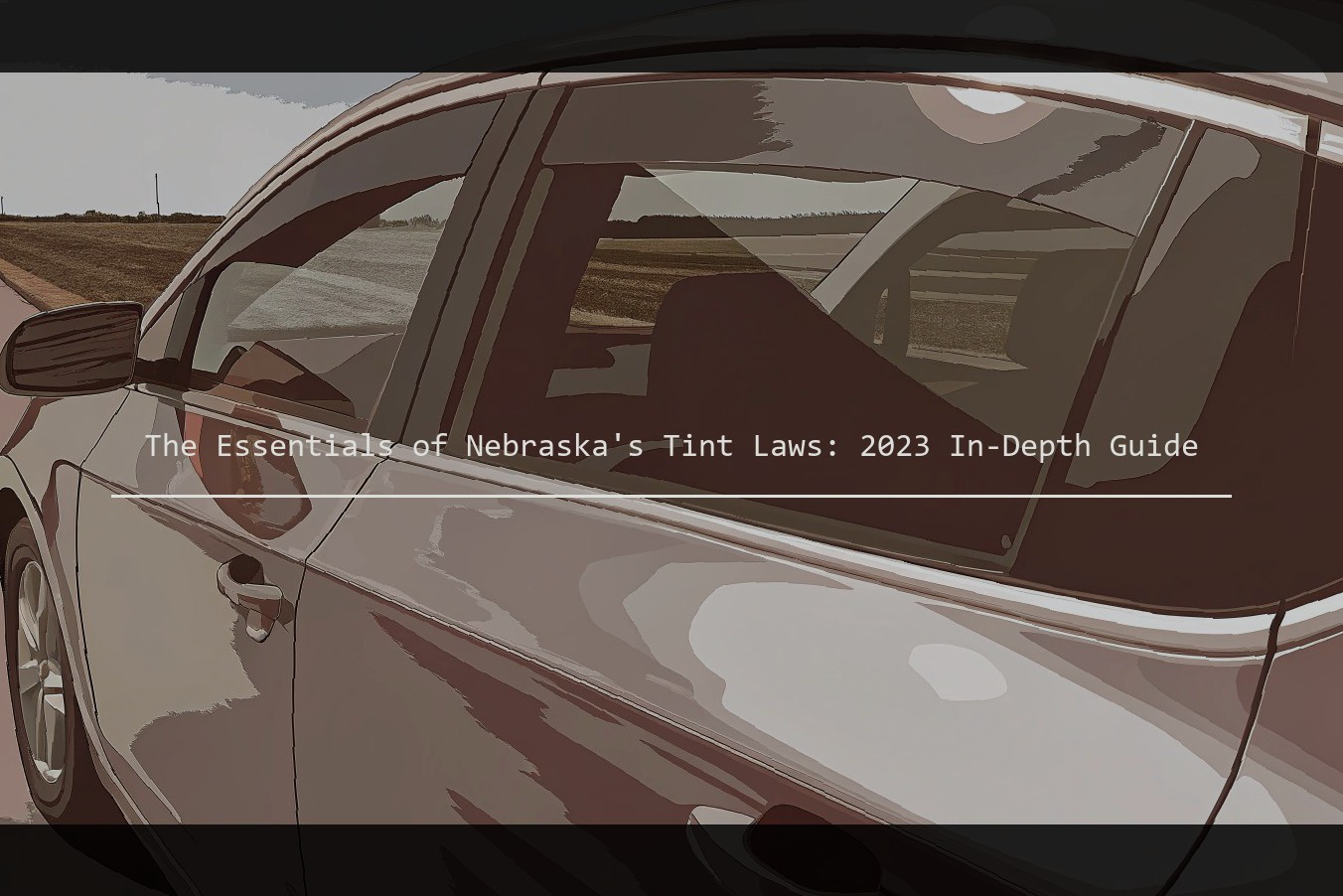Overview of Nebraska Window Tinting Laws
The window tint laws in Nebraska, like many states across the country, play a crucial role in ensuring both the safety of drivers and the legality of motor vehicles. These regulations are designed to create a standard for window tinting to enhance both comfort and safety. In this section of our blog post dedicated to Nebraska tint laws for 2023, we will explore the basic requirements for window tinting under Nebraska law, the purpose of these laws in the context of driving safety, and how they apply to law enforcement practices.
Nebraska’s window tint law is comprehensive and outlines the legal amounts of tint for each window in a vehicle. The state sets two different types of endorser for legal window tint – "Certified" and "Medical". The endorser type determines the percent of allowable tint on each of a vehicle’s windows.
The "Certified" endorser may range from a dark tint to a clear tint. This endorser allows for all windows to meet Division A Regulation 002.03 with a tint darkness of up to 20 percent (0 percent reflection).
The "Medical" endorser is available to a person with a condition that causes the eyes extreme discomfort when exposed to sunlight and that could be alleviated by a reduction in sunlight through tinted glass in the vehicle . In such cases, the tint darkness of the windshield is required to be no more than 35 percent and tint darkness of any other window is required to be no more than 20 percent. In addition, the endorser type restricts the total amount of side and rear windows to be tinted to no more than 70 percent. In terms of endorser type, there is no daylight requirement.
The primary reason these window tint requirements exist throughout the state of Nebraska is to ensure that those people who are operating the motor vehicles on these roadways know the risks that can come when their vision is obscured. It is very difficult for an officer or another motorist to view inside a vehicle that has dark tinting, which can make it difficult for an officer to conclude whether the driver is a threat. Additionally, if the tint creates an obstruction for the driver of the vehicle, it increases the risk for a possible accident.
Because the primary purpose of Nebraska window tint law is to exist as a safeguard for all motorists on the roadway, it is important that all operators of motor vehicles on Nebraska roads are aware of these restrictions in place.

Legal Tint Darkness for Different Types of Automobiles
Nebraska tint laws offer relatively minor variation based on the type of vehicle. For almost all types of passenger vehicles, including SUVs, the rear windows are allowed to be as dark as you want. Nebraska tint laws allow the rear windows of passenger vehicles to have a darkness level of 5% VLT. Even such a low VLT will not attract the attention of police. The only type of vehicle in which Nebraska tint laws are stricter than average is vans. Rear windows on vans must allow a minimum of 20% VLT. For other types of vehicles, Nebraska tint laws specify a minimum of 35% VLT for both the front side windows and the windshield strip. Again, the tint can be darker, but it cannot be less than 35% VLT.
Fines and Penalties for Illegal Tint
Violating Nebraska’s tint law with your car windows can lead to a number of complications. Window tint violations aren’t just seen as civil infractions; instead, they can lead to fines, various citations and even court appearances. Not adhering to the tint laws for cars in Nebraska is considered a direct violation of the law, and this is punishable by law.
If you’re pulled over for window tint violations, one thing you won’t be able to do is claim you don’t know about the law. Every single owner or operator of a motor vehicle should know and understand the state’s tint laws. These laws are available online and through your local law enforcement and motor vehicle departments. There’s no excuse when it comes to illegal window tint, and you’ll need to pay for your violation.
Any infraction with your tint can lead to a significant fine. If you’re pulled over for window tint that violates the law, you’ll be pulled over and cited for a window tint violation. Alternatively, if you’re pulled over for a different infraction and your car tint is detected, you’ll also be charged.
Window tint violations can lead to minor fines, such as $10. However, most first-time, minor tint law violations result in a $50 fine. Repeat offenders or those with more serious tint violations will face fines of between $100 and $1,000. …Exceeding the tint percentage on the front windshield by any amount is an offense punishable with a $25 fine for first-time offenders. Subsequent offenses can lead to fines of between $300 and $500 on average. If there’s visible tint on the front windshield, those fines usually exceed $200. The same holds true for tint on the rear windshield. If you have visible tint on the windshield or excessive tint levels, you’ll probably be fined. …There are a number of ways a police officer can spot excessive tint on the windows of your car. They’ll likely use a tint meter to check the tint of your front sidetint. If the tint is too dark in their opinion, they’ll issue you a citation and have you correct the problem before being sent on your way.
Exceptions and Exemptions to the Rules
Despite the generally strict tint laws for passenger cars, there are instances where a vehicle will be exempt from these stringent regulations. As mentioned above, the exemption should be requested by the owner of the vehicle, and for some situations, a valid medical exemption will be needed.
Any individual with a medical condition which requires the use of solar lenses or regular raising of the window tint above those that are otherwise permitted should request an exemption from the Nebraska Department of Highway Safety and Motor Vehicles. This includes those suffering from solar burns, actinic keratosis, malignant skin cancer, lupus erythematosus, PEH, and others who must protect their eyes from harmful UV rays.
This application process requires a doctor’s prescription or written statement to be submitted along with the request . However, the tint must match those already permitted below. For example, if the individual with the medical condition is granted permission for a tint of 15%, the regular drivers are only allowed 20%, the permitted tint will then be 20%.
There are exemptions in place for factory tint on new vehicles as well. The tinted windows of your new vehicle still must meet the requirements for medical exemptions, otherwise the maximum tint allowed in Nebraska will apply. Additionally, any vehicle that is not considered a "passenger car" (transport vans or pickup trucks) will also be given exemptions from the tint laws issued by the state of Nebraska.
If granted, exemptions will be permanent on the record until such time as it is identified in a law enforcement database.
Choosing Legal Window Tint Products
Understanding Nebraska’s tint laws is only half the battle when it comes to getting the right window tint for your car. The actual product you put on your vehicle’s windows must be legal. This may seem obvious, but you would be amazed how many cars are outfitted with tints that do not meet Nebraska’s tint laws, simply because the owner didn’t know better or failed to do their research.
The law requires that all tinting installed on a vehicle must allow a certain amount of light through. How much light passes through is the visible light transmission (VLT) percentage. The darker the tint, the less light passes through. The manufacturer of the tint should have that information on their website and/or on a sticker on the tint itself. If you have tinted and the tint is too dark or too reflective, then you will need to replace it with something compliant. It is also worth mentioning that tint cannot be red or amber on the driver and passenger windows, even if it complies with VLT numbers.
Keep in mind that VLT is not the only legal requirement for window tint. The law in Nebraska mandates that tint must meet the two qualifications listed here:
There are three ways you can ensure you are getting a product that meets Nebraska’s tint laws.
Professional installers should know Nebraska’s tint laws like the back of their hand. A good installer will have an installed percentage chart that they follow, which varies slightly from vehicle to vehicle. If they are not following the law, then they are breaking the law and they are not the right installer for you. When a tint is applied, the installed VLT should be no higher than the legal percentage shown on the manufacturer’s documentation. Professional installers should be willing to provide legal percentages. If your tint doesn’t comply with Nebraska tint laws, return and have it removed.
Tint films come in all shades of visible light transmission percentages. It is important that you choose a legal tint, which will vary from vehicle to vehicle. A good installer should ask if you have a vehicle that has been factory tinted or darkly tinted before they tint it again. Also, not all tints are available for all vehicles, so check with the film’s manufacturer to confirm the tint was designed for your specific vehicle.
Best Practices for Good Visibility with Tinted Windows
Driving with tinted windows can sometimes be challenging, especially in low-light situations. Drivers are advised to use extra caution and take appropriate measures to ensure safe driving at all times.
First, ensure that the tint on your vehicle’s windows meets Nebraska’s tinting laws. Use a light transmittance meter (available from car accessory retailers or tint shops) to check the VLT of your tinted windows. If the tint is too dark, consider replacing it with a lighter shade to improve visibility, or be aware of how to maximize your rear view mirrors and use them effectively.
Second, keep your windshield free of debris that can obstruct your view through the front window (such as frost, dust, dirt, and grime). Use a quality windshield cover when parked to reduce cloudiness caused by moisture or frost. Additionally, regularly wash and apply a high-quality treatment product, such as Rain-X or Aquapel, to your windshield to improve water beading and enhance your visual field in wet conditions .
Third, make sure all your headlights and tail lights are working properly. When driving at night, using your high beams will provide better visibility. If you have severely tinted windows and must parallel park, roll down your windows to better judge distances, or use your rear view camera and parking sensors to aid in backing up.
Lastly, be mindful of how you drive. When backing out of a parking lot or driveway, proceed slowly and carefully. Always use your mirrors and visually scan around your vehicle for any pedestrians, cyclists, and oncoming traffic. Maintain safe distance from other vehicles to allow extra stopping time in an emergency.
In summary, tinted windows can reduce your view of the road; however, following these guidelines will help to maintain good overall visibility while driving at night or in inclement weather.
